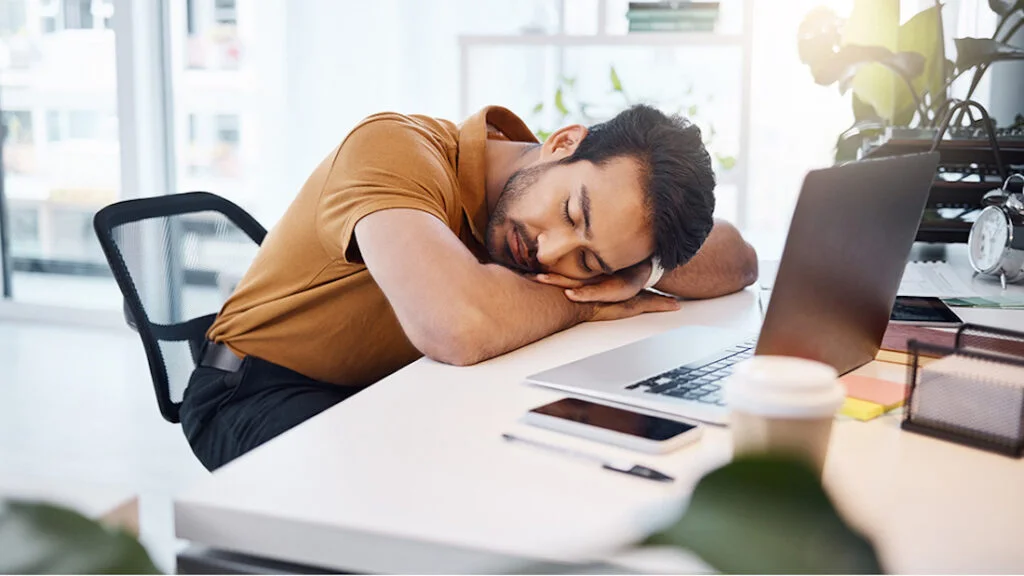
While an afternoon power nap can increase focus, energy, and drive to get through the rest of your daily to-dos, timing is everything. Just like a venti dark roast provides a pick-me-up in the morning, but nightly consumption may leave you tossing and turning and strung out the next day, so too do power naps have the ability to make or break your energy levels.
TikTok creator Tony Aube illustrates this in a video showing a planned power nap at 6 p.m., leading to him waking up 8 hours later, sweaty, disoriented, and clearly distressed about having missed the rest of his day (1). So, how can you harness the power of a daily nap without completely derailing your day? We asked Dr. Chester Wu, a double board-certified in Psychiatry and Sleep Medicine and medical reviewer for the sleep tracker app Rise, to find out.
Late Naps Make It Harder To Fall and Stay Asleep
According to Wu, taking naps late in the day, particularly in the late afternoon or evening, can disrupt your nighttime sleep because it reduces the natural build-up of the need for sleep that happens over the day, an effect known as sleep-drive. Sleeping later in the day diminishes its intensity, making falling and staying asleep harder.
Additionally, says Wu, it will be harder to take naps in the late afternoon or evening because you’ll be getting your “second wind”— the second burst of energy you get during the day, thanks to your circadian rhythm, the body’s internal clock that regulates sleep and wake cycles over 24-hours.
Finding the Ideal Power Nap Length
Wu says a power nap is short, ideally 10-20 minutes long. “This duration allows you to reap the benefits of a short nap, such as increased alertness and improved mood, without falling into a deeper stage of sleep, which can result in post-nap grogginess or sleep inertia,” he says. Sleep inertia
A review of the studies on the subject shows mixed results. Some show shorter naps of 20–30 min that contain N2 (the second stage of REM when memories are formed), and slow wave sleep may boost alertness, while naps of at least 60 minutes can improve memory function (3).
However, other research shows shorter naps of 30 min were also beneficial for memory consolidation even without much slow-wave sleep. Another report found that just 6 minutes of sleep was enough to improve memory.
Another study investigating different nap lengths (5, 10, 20, and 30 minutes) found that 10-minute naps best increased alertness. However, napping longer than 10 minutes was more likely to include slow-wave sleep, which did the opposite.
The realistic answer is that it varies. Researchers suggest the ‘optimal’ nap length likely depends on your lifestyle factors, such as how long you typically sleep each night, your current nap routine, and what you hope to get out of your nap time (2). Experimenting to see what works best for you is wise.
Deciding When To Nap For Best Results
Power naps are best taken at a time that aligns with the body’s natural circadian dip in alertness, which depends on your chronotype, according to Wu. Early birds will have an earlier window in the afternoon, while night owls will skew later. “For most of us, this will be sometime between 1 p.m. and 4 p.m. It will not only be easier to fall asleep when our energy naturally lulls, he says, but it’s also an ideal time to recharge without affecting your nighttime sleep (assuming you keep your nap short).
Research shows that mid-day naps help counteract sleepiness, increase memory consolidation and executive functioning (crucial for planning and focus), set you up to learn new things, and improve moods. Some research shows naps between 12:30 p.m. and 4:50 p.m. (with 2:00 p.m. being the most common) improve cognitive and physical performance and reduce feelings of fatigue.
What’s more, these benefits are seen regardless of whether or not you had a great sleep the night before. Although there isn’t a set-in-stone time, most experts agree that 3 p.m. is a good average cut-off time to begin a nap.
Who Can Benefit From Power Naps?
According to Wu, most people can benefit from a power nap. “Power naps can help you make up for lost sleep, although a longer nap will certainly help you make up for more, as well as provide a temporary boost of energy, even if you’re not sleep deprived,” he says.
Going back to that venti Starbucks, Wu insists a power nap is better than reaching for a cup of coffee, which, he says, will likely disrupt that night’s sleep if drunk after noon. A power nap is less likely to get in the way of the sleep drive necessary for staying and falling asleep, especially if taken at the right time of day. “Unless you’re quite sleep-deprived, you should be able to ease right back into your daily activities after a power nap, whereas you’ll have to wait out sleep inertia after a longer nap,” he says.
Wu does not recommend taking any type of nap if you experience insomnia or are trying to shift your sleep schedule to an earlier wake-up time. In both cases, you need as much sleep pressure to build as possible in both cases.
Sources
1. @tony.aube; TikTok; https://www.tiktok.com/@tony.aube/video/7285926726792695083?_r=1&_t=8gYn4nMqPZW; October 3, 2024.
Wu, Dr. Chester. Author interview. October 2024.
2. Janna Mantua, Rebecca M.C. Spencer, “Exploring the nap paradox: are mid-day sleep bouts a friend or foe?,” Sleep Medicine, Volume 37, 2017, Pages 88-97, ISSN 1389-9457, https://doi.org/10.1016/j.sleep.2017.01.019.
3. Ruth L.F. Leong, June C. Lo, Michael W.L. Chee, “Systematic review and meta-analyses on the effects of afternoon napping on cognition,” Sleep Medicine Reviews, Volume 65, 2022, 101666, ISSN 1087-0792, https://doi.org/10.1016/j.smrv.2022.101666.


























